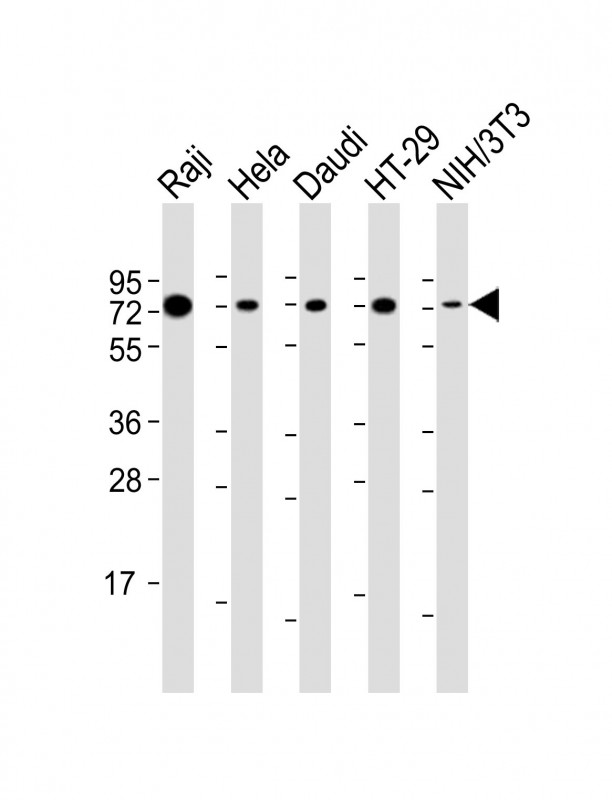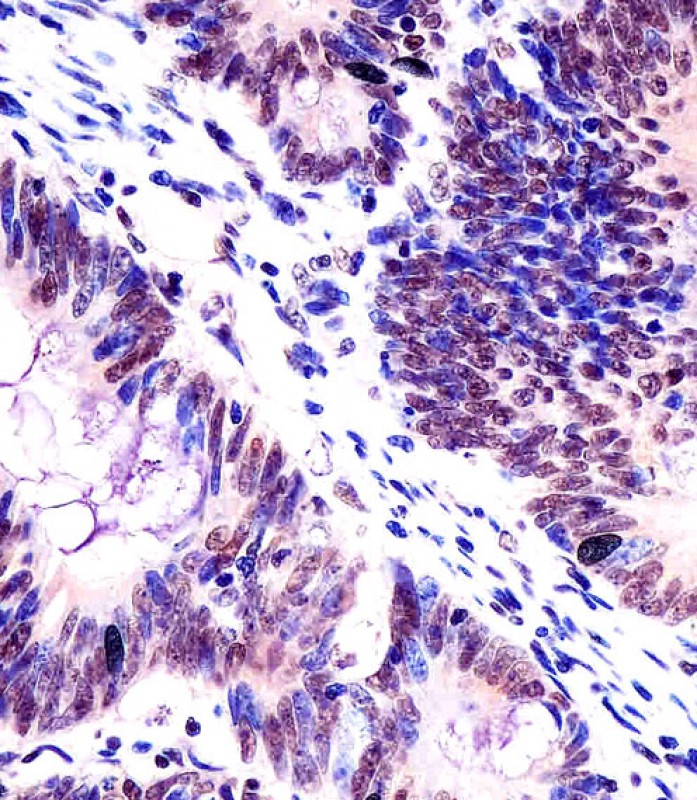

| WB | 1/2000 | Human,Mouse,Rat |
| IF | 咨询技术 | Human,Mouse,Rat |
| IHC | 1/100-1/500 | Human,Mouse,Rat |
| ICC | 技术咨询 | Human,Mouse,Rat |
| FCM | 咨询技术 | Human,Mouse,Rat |
| Elisa | 咨询技术 | Human,Mouse,Rat |
| Aliases | KH domain-containing, RNA-binding, signal transduction-associated protein 1, GAP-associated tyrosine phosphoprotein p62, Src-associated in mitosis 68 kDa protein, Sam68, p21 Ras GTPase-activating protein-associated p62, p68, KHDRBS1 (HGNC:18116) |
| Entrez GeneID | 10657 |
| WB Predicted band size | 48.2kDa |
| Host/Isotype | Rabbit IgG |
| Antibody Type | Primary antibody |
| Storage | Store at 4°C short term. Aliquot and store at -20°C long term. Avoid freeze/thaw cycles. |
| Species Reactivity | Human, Mouse, Rat |
| Immunogen | This KHDRBS1 antibody is generated from a rabbit immunized with a KLH conjugated synthetic peptide between 259-291 amino acids from the Central region of human KHDRBS1. |
+ +
以下是关于KHDRBS1(Sam68)抗体的3篇参考文献,涵盖不同研究方向的摘要概括:
---
1. **文献名称**:*Sam68 regulates EMT through alternative splicing-activated nonsense-mediated mRNA decay driving the transition of breast cancer to metastasis*
**作者**:Chen et al. (2020)
**摘要**:研究利用KHDRBS1抗体进行免疫沉淀和Western blot分析,发现Sam68通过调控选择性剪接和非依赖性mRNA降解通路促进乳腺癌上皮间质转化(EMT),驱动转移进程。
---
2. **文献名称**:*The RNA-binding protein Sam68 is a multifunctional player in human cancer*
**作者**:Lukong & Richard (2014)
**摘要**:该综述总结了Sam68(KHDRBS1)在肿瘤发生中的作用,强调其抗体在多种癌症模型中的应用,包括免疫组化和共聚焦显微镜技术揭示其在信号通路及RNA代谢中的调控机制。
---
3. **文献名称**:*Sam68 interacts with the CD44v3 containing isoform in colon cancer cells and regulates Akt phosphorylation*
**作者**:Paronetto et al. (2011)
**摘要**:通过KHDRBS1抗体的免疫共沉淀实验,研究发现Sam68与结肠癌细胞中CD44v3异构体结合,激活Akt磷酸化通路,促进肿瘤细胞存活和侵袭。
---
如需更多文献或具体细节,可进一步在PubMed或Google Scholar中检索关键词“KHDRBS1 antibody”或“Sam68 antibody”。
KHDRBS1 (KH RNA Binding Domain Containing, Signal Transduction Associated 1), also known as Sam68. is a RNA-binding protein belonging to the STAR (Signal Transduction and Activation of RNA) family. It plays a critical role in post-transcriptional gene regulation, including RNA splicing, transport, stability, and translation. KHDRBS1 interacts with various signaling pathways (e.g., MAPK, Src) and is involved in cellular processes like cell cycle progression, apoptosis, and differentiation. Its dysregulation has been linked to cancers, neurological disorders, and viral infections.
Antibodies targeting KHDRBS1 are widely used to study its expression, localization, and molecular interactions. These antibodies are typically developed in hosts like rabbits or mice using immunogens derived from specific regions of the human KHDRBS1 protein. Validated applications include Western blotting, immunofluorescence, immunoprecipitation, and immunohistochemistry. High-quality KHDRBS1 antibodies are often verified using knockout cell lines or siRNA-mediated knockdown to confirm specificity. Researchers employ these tools to explore KHDRBS1's role in RNA metabolism, its oncogenic potential in tumors (e.g., prostate, breast cancers), and its involvement in neurological conditions like autism spectrum disorders. Proper validation remains essential due to potential cross-reactivity with related STAR family members.
×